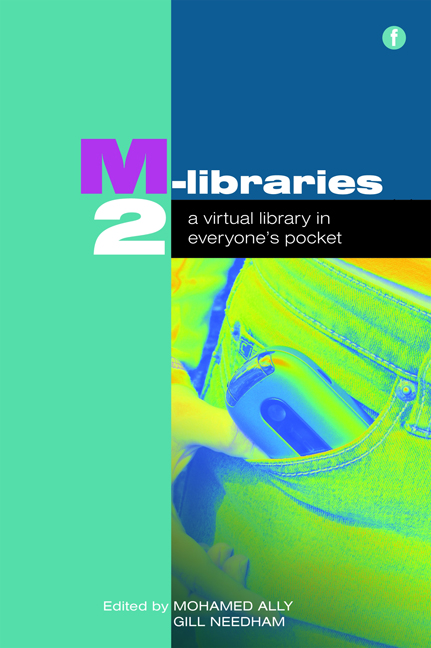Book contents
- Frontmatter
- Contents
- Acknowledgements
- Contributors
- Foreword
- Introduction
- PART 1 M-LIBRARIES: DEVELOPMENTS AROUND THE WORLD
- PART 2 TECHNOLOGY IN M-LIBRARIES
- PART 3 APPLICATION OF M-LIBRARIES
- PART 4 M-LIBRARIES AND LEARNING
- 18 Mobilizing the development of information skills for students on the move and for the workplace: two case studies of mobile delivery in practice
- 19 The library's place in a mobile space
- 20 M-libraries in distance education: a proposed model for IGNOU
- 21 Bridging the mobile divide: using mobile devices to engage the X and Y generations
- 22 Information literacy gets mobile
- 23 Library and Student Support (L&SS): flexible, blended and technology-enhanced learning
- PART 5 BUILDING THE EVIDENCE BASE FOR M-LIBRARIES
- Conclusion
- Index
22 - Information literacy gets mobile
from PART 4 - M-LIBRARIES AND LEARNING
Published online by Cambridge University Press: 08 June 2018
- Frontmatter
- Contents
- Acknowledgements
- Contributors
- Foreword
- Introduction
- PART 1 M-LIBRARIES: DEVELOPMENTS AROUND THE WORLD
- PART 2 TECHNOLOGY IN M-LIBRARIES
- PART 3 APPLICATION OF M-LIBRARIES
- PART 4 M-LIBRARIES AND LEARNING
- 18 Mobilizing the development of information skills for students on the move and for the workplace: two case studies of mobile delivery in practice
- 19 The library's place in a mobile space
- 20 M-libraries in distance education: a proposed model for IGNOU
- 21 Bridging the mobile divide: using mobile devices to engage the X and Y generations
- 22 Information literacy gets mobile
- 23 Library and Student Support (L&SS): flexible, blended and technology-enhanced learning
- PART 5 BUILDING THE EVIDENCE BASE FOR M-LIBRARIES
- Conclusion
- Index
Summary
The pervasiveness of mobiles gives a great new opportunity for librarians to reach their users. Within the context of the changing landscape mapped by Google generation reports (CIBER, 2008), information literacy (IL) remains a crucial deficit area. The use of mobiles for IL could be seen as an extension of Web 2.0, e.g. podcasts and screen casts. These are becoming mainstream for the new librarian. Adoption of mobile devices in libraries is in its early days because of the limitations of the technology and the variety of devices owned. There are serious limitations, and it is time to experiment. This chapter discusses the potential, looks at present practice and suggests ways forward.
The mobile background
By the end of 2008, there were over four billion mobile subscriptions worldwide, representing 61% of the population, and there were 335 million broadband subscribers. By contrast, just under a quarter of the 6.17 billion world population use the internet (International Telecommunication Union, 2009). Mobile devices are so widespread that the most common items we carry around with us are keys, money and the mobile phone. The ECAR study 2008 in the USA (Salaway et al., 2008) found that 66.1% had internet-capable mobile phones, and of these 25.9% accessed the internet once a week or more. In 2007, 14% accessed the internet on a mobile device on a typical day and 32% had never used the internet on a mobile at any time. This had changed in 2009 to 23% and 38% respectively (Pew Internet & American Life Project, 2009). As McIntosh (2008) said ‘it's about time schools sharpened their focus on how they can help students power up their learning with their mobile devices, rather than have them power down at the school door.’ I believe the same is true for libraries.
Another way of engaging?
Much has been written about finding ways of engaging with the web generation. The CIBER report has transformed this debate and brought the realization that we are all part of this generational change and exhibit some of its so-called major characteristics, such as preferring to learn via small chunks of information (CIBER, 2008). Crucially, it found that not all users are equally technically proficient – geeks are in the minority, and the lack of IL is a real concern.
- Type
- Chapter
- Information
- M-Libraries 2A virtual library in everyone's pocket, pp. 205 - 214Publisher: FacetPrint publication year: 2010



